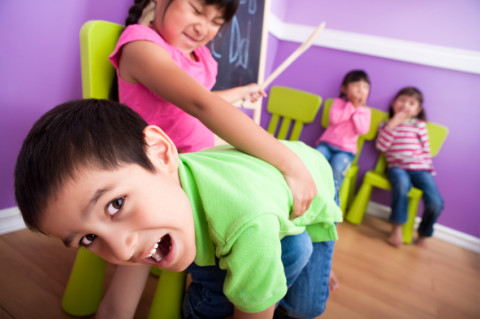Spare the Rod, Spoil the Child – How the Prescription Pad Replaced the Paddle.
 Fifty years ago, if a child misbehaved, he got a good paddling. Today, society frowns on slapping and spanking kids, with corporeal punishment outlawed in all but 19 states.
Fifty years ago, if a child misbehaved, he got a good paddling. Today, society frowns on slapping and spanking kids, with corporeal punishment outlawed in all but 19 states.
While RxBalance is happy that our society no longer sees spanking as an appropriate response to misbehavior, we are concerned that Americans seem so at ease with drugging kids who are irritating, moody and temperamental. Sadly, there are children so destructive to themselves and others that medication is necessary. We are not addressing children such as these in this blog.
Risperdal, Zyprexa, Abilify, Geodon, Seroquel. Atypical antipsychotics (often called second-generation agents) are now the fifth top-selling drug class in the United States, with sales of $18.2 billion in 2011, according to IMS Health. Their use in children with behavior and emotional problems is now as American as apple pie. In fact, Americans spend about as much on antipsychotic drugs as we do on drugs for cancer or diabetes.
First introduced in the 1990s for schizophrenia – atypical antipsychotics were promoted as being relatively benign – with fewer side effects than older drugs like Haldol, Thorazine and Mellaril. Due to the perception of enhanced safety (promulgated by the pharmaceutical industry), use of atypical antipsychotics has skyrocketed in children and adolescents in the past 15 years. Today atypical antipsychotics are used for a myriad of off-label indications (with questionable supporting evidence) in children and adolescents, including ADHD, mood disorders and oppositional behaviors such as aggression, arguing with parents, having angry outbursts or being defiant. While the rates of psychiatric drugs have mushroomed in both privately and publicly insured youth, psychiatric medication use is especially high in kids in foster care. The excessive rate of psychiatric medication use in foster children – with some states reporting overall psych med use as high as 66% in adolescents 12 to 17 years old – has resulted in several high-profile national investigations leading to Medicaid taking a variety of measures to try to regulate antipsychotic prescribing.
Why are psych medications so popular for treating emotional and behavioral issues in youth in the U.S? Some researchers attribute it to reimbursement policies, diagnostic classification systems or cultural beliefs regarding the role of medication treatment. Most see aggressive marketing as a factor in the rise of antipsychotic prescribing to kids. But whatever the reason, prescribing psychiatric drugs to manage childrens’ emotional and behavioral conduct is a trend that is much more popular in America than Europe. American children are about three times likelier to be prescribed psychiatric meds compared to children in Western Europe, with use of antidepressant and ADHD medications three or more times greater in the U.S. than in the Netherlands and Germany.
So while using a hair brush to whack a kid at school is prohibited, you may find some of the facts and figures regarding antipsychotic drug use hair raising!
- Between 1993 and 2003, there was a 500% increase in the number of office visits in which children received a prescription for antipsychotic drugs. Source: Arch Gen Psychiatry. 2006;63(6):679-685.
- 25% of American children on atypical antipsychotic medication are less than nine years old, even though researchers know little about their long-term effects on the developing brain. Source: Arch Pediatr Adolesc Med. 2005;159(4):362-366.
- The Texas Medicaid program saw a 494% increase in the rate of youth receiving atypical antipsychotics between 1996-2000, with an increase of 609% in children 5 to 9 years. Source: J Child Adolesc Psychopharmacol. 2002;12(3):221-229.
- American kids are prescribed psychiatric drugs much more than in other industrialized countries. Antidepressants and stimulants are used at rates 3 or more times more frequently in the U.S. vs. Netherlands and Germany; stimulant use is 10–25 times higher in U.S. children aged 0 to 4 years compared to other Western European countries. Source: Child Adolesc Psychiatry Ment Health. 2008;2(1):26
Today, Americans no longer reach for the paddle to punish misbehavior in children. Instead, we reach for the prescription pad. Perhaps someday we will look back and question the practice of using powerful psychiatric medications to manage emotional and behavioral problems in children. For now, we seem to accept a cultural norm that judges corporeal punishment as cruel and abusive, but sees medicating bad behavior as an acceptable way of dealing with troubled kids.

5 Comments
This is very nice blog you are sharing. Follow meddco healthcare https://www.meddco.com/ for the best affordable healthcare treatment and packages.
Thanks Anonymous for pointing out the discrepancy between the source document and the dollar figure cited in the blog. I just updated the dollar amount so it is now correct.
Risperdal, Zyprexa, Abilify, Geodon, Seroquel. Atypical antipsychotics (often called second-generation agents) are now the fifth top-selling drug class in the United States, with sales of $18.2 billion not $19.6 billion from 2011
It is a sad commentary on our current societal trend of modifying children’s behavior via atypical antipsychotics. We seem to be trading one evil method for another, propagated by lucrative marketing practices by pharmaceutical conglomerates. What society needs is a tool, that is both physically and mentally healthy, that will modify aberrant childhood behavior.
Thanks to RX Balance and Ms Green for opening this issue to discussion.
Thank God!! This is fantastic. It’s about time this news was shared! I’m so happy about RxBalance and your dogged determination to tell the truth.
Topics
Share